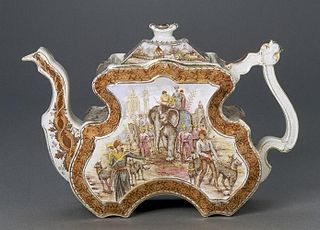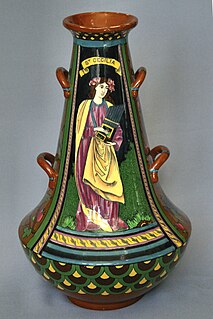Susan Vera "Susie" Cooper was a prolific English ceramic designer working in the Stoke-on-Trent pottery industries from the 1920s to the 1980s.

Hanley, in Staffordshire, England, is a constituent town of Stoke-on-Trent. Hanley was incorporated as a municipal borough in 1857 and became a county borough with the passage of the Local Government Act 1888. In 1910, along with Burslem, Tunstall, Fenton, Longton and Stoke-upon-Trent it was federated into the county borough of Stoke-on-Trent. Hanley was the only one of the six towns to be a county borough before the merger; its status was transferred to the enlarged borough. In 1925, following the granting of city status, it became one of the six towns that constitute the City of Stoke-on-Trent.

Creamware is a cream-coloured, refined earthenware with a lead glaze over a pale body, known in France as faïence fine, in Germany as Engels porselein and Italy as terraglia inglese. It was created about 1750 by the potters of Staffordshire, England, who refined the materials and techniques of salt-glazed earthenware towards a finer, thinner, whiter body with a brilliant glassy lead glaze, which proved so ideal for domestic ware that it supplanted white salt-glaze wares by about 1780. It was popular until the 1840s.

Charlotte Rhead was an English ceramics designer active in the 1920s and the 1930s in the Potteries area of Staffordshire.

Stoke-on-Trent Metropolitan Area, also known as The Potteries Metropolitan Area, or North Staffordshire, is an area of England, consisting of the Stoke-on-Trent, Newcastle-under-Lyme and Staffordshire Moorlands local authority areas. As of 2016 it had a population of 678,000.

Burleigh Pottery is the name of a pottery manufacturer in Middleport, Stoke-on-Trent. The business specialises in traditionally shaped and patterned domestic earthenware of high quality.

J. & G. Meakin was an English pottery manufacturing company founded in 1851 and based in Hanley, Stoke-on-Trent, Staffordshire.

The Potteries Museum & Art Gallery is in Hanley, one of the six towns of Stoke-on-Trent in Staffordshire. Admission is free.

Pâte-sur-pâte is a French term meaning "paste on paste". It is a method of porcelain decoration in which a relief design is created on an unfired, unglazed body, usually with a coloured body, by applying successive layers of (usually) white porcelain slip with a brush. Once the main shape is built up, it is carved away to give fine detail, before the piece is fired. The work is very painstaking and may take weeks of adding extra layers and allowing them to harden before the next is applied.
Dorothy Jessie Tait was a prolific English ceramic designer working in the Stoke-on-Trent pottery industries, most prominently for Midwinter, from the 1940s to the 1980s.
Frederick Alfred Rhead (1856–1933) was a potter working in North Staffordshire, England. He is not to be confused with his son Frederick Hurten Rhead (1880–1942) who was also a potter, and who worked mainly in the USA. His other children included the pottery designer Charlotte Rhead.

Louis John Rhead was an English-born American artist, illustrator, author and angler who was born in Etruria, Staffordshire, England. He emigrated to the United States at the age of twenty-four.

Marc-Louis-Emmanuel Solon, pseudonym Miles, was a renowned French porcelain artist. After beginning his career at the Sèvres Pottery, he moved to Stoke-on-Trent in 1870 to work at Mintons Ltd, where he became the leading exponent of the technique of ceramic decoration called pâte-sur-pâte. His work commanded high prices in the late Victorian period.
Gordon Mitchell Forsyth (1879–1952) was a Scottish ceramic designer and fine artist and art education innovator.

Shelley Potteries, situated in Staffordshire, was earlier known as Wileman & Co. which had also traded as The Foley Potteries. The first Shelley to join the company was Joseph Ball Shelley in 1862 and in 1896 his son Percy Shelley became the sole proprietor, after which it remained a Shelley family business until 1966 when it was taken over by Allied English Potteries. Its china and earthenware products were many and varied although the major output was table ware. In the late Victorian period the Art Nouveau style pottery and Intarsio ranges designed by art director Frederick Alfred Rhead were extremely popular but Shelley is probably best known for its fine bone china “Art Deco” ware of the inter-war years and post-war fashionable tea ware.
Percy Shelley (1860–1937) was an English potter and a major force in developing Shelley Potteries. He was born in Longton, Staffordshire. He attended Owen's College, Manchester and then London University, where he gained a B.A. degree.

American art pottery refers to aesthetically distinctive hand-made ceramics in earthenware and stoneware from the period 1870-1950s. Ranging from tall vases to tiles, the work features original designs, simplified shapes, and experimental glazes and painting techniques. Stylistically, most of this work is affiliated with the modernizing Arts and Crafts (1880-1910), Art Nouveau (1890–1910), or Art Deco (1920s) movements. Art pottery was made by some 200 studios and small factories across the country, with especially strong centers of production in Ohio and Massachusetts. Most of the potteries were forced out of business by the economic pressures of competition from commercial mass-production companies as well as the advent of World War I followed a decade later by the Great Depression.
Bernard Moore (1850-1935) was an English pottery manufacturer and ceramic chemist known for the innovative production of flambé glazes and pottery with reduced lustre pigments. After forty years running his family's pottery business, he set up his own pottery studio in Stoke-on-Trent where he made art pottery with the help of a few assistants. After closing the studio, he worked as a ceramic consultant.

















